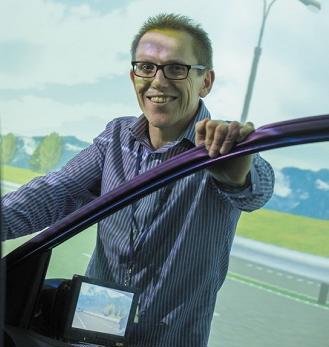Autonomous taxis could soon join fleets in cities across the UK after a blueprint infrastructure was created by a major national research project.
ServCity, funded by the government's £100m Intelligent Mobility Fund and administered by the Centre for Connected and Autonomous Vehicles (CCAV), was delivered by Innovate UK over the past three years.
Six project partners - the University of Nottingham, Nissan, Connected Places Catapult, TRL, Hitachi Europe and SBD Automotive - have been working to understand how to help cities get CAV ready and successfully incorporate autonomous vehicle technologies into complex urban environments to deliver "Robotaxi" style services and create a template for the type of infrastructure required to support these technologies.
Professor Gary Burnett, Chair of Transport Human Factors from the Human Factors Research Group at the University of Nottingham, said: "ServCity has supported us to develop novel, human-centred methodologies for designing and evaluating the user experience for future autonomous taxis."

Using innovative virtual reality (VR) and field observation methodologies, we have focussed on the inclusive design of interfaces for vehicle occupants and other road users, which deliver a positive user experience in the absence of a human driver.
Gary continued: "Accessibility has been at the forefront of our research, with contributions from a wide range of potential stakeholders to inform all stages of our work. We have also examined human factors considerations for remote operators who might contribute to the user experience from afar."
Built upon a 100% electric Nissan LEAF, a series of increasingly challenging validation trials have been completed in the real-world environment of TRL's Smart Mobility Living Lab (SMLL). This enabled ServCity to leverage the testbed's full capabilities to create a futuristic cooperative infrastructure environment that sends data to the CAV to improve its situational awareness – for example, alerting it to the intention of an unseen bus stop ahead.
David Moss, Senior Vice President, Region Research & Development for Nissan AMIEO (Africa, Middle East, India, Europe, and Oceania), said: "We are extremely proud to be a part of the ServCity project and our 100% electric Nissan LEAF has proven to be the ideal test vehicle. Through our Nissan Ambition 2030 long-term vision, we are committed to supporting greater access to safe and exciting mobility. Advancing our autonomous drive capability and expertise is critical to this effort and research projects such as ServCity are vital to the evolution of technology."
Thomas Tompkin, Head of Network Infrastructure and Operations of TRL's SMLL, said: "ServCity is what the Smart Mobility Living Lab was conceived for – to test emerging technologies safely in a real-world urban testbed and accelerate their commercialisation."
I'm so proud of our engineering team who have supported all the partners in the ServCity project, pushing the boundaries every day to get us one step closer to a transport system that is cleaner, safer, and more accessible.
At the heart of ServCity is the aim to prove that autonomous technology can provide a truly people-centric mobility service, and what road infrastructure adjustments will enable the best user experience possible.
Edward Mayo, Programme Manager at Connected Places Catapult, said: "Throughout the project, Connected Places Catapult has been demonstrating the art of the possible in scaling CAV technologies, and their supporting infrastructure, to help get these vehicles delivering vital services as soon as possible. Based on the potential demand for a CAV service, combined with potential areas of operation, the Catapult has helped create a blueprint that provides a basis for follow-on work by many other organisations and aims to assist and enable the full-scale deployment of an operational Robotaxi service in a UK city."
Nick Blake, Chief Innovation Strategist at Hitachi Europe, said: "The ServCity project has allowed us to further develop the essential technologies needed for urban driving, such as the ability to make safe decisions based on advanced situational awareness, and robust localisation in urban canyons – where GPS signals may not be reliable. We've made massive strides in the past three years, and we will continue to participate in the autonomous driving revolution".
Robotaxis have the potential to fundamentally transform mobility for both consumers and the cities they operate in.
Andrew continued: The user experience lies at the heart of that transformation, as operators will need to carefully balance customer expectations with real-world technological constraints imposed by both vehicles and city infrastructure. The ServCity project has seen theory put into practice, so we are now confident of being able to help car makers design a seamless Robotaxi experience."
The project is an important step towards giving people the confidence that CAVs are safe to introduce onto UK roads, with the conclusion of the project being celebrated with a series of demonstrations where people were able to experience the technology for themselves.






